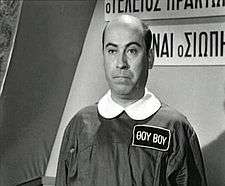Cinema of Greece
| Cinema of Greece | |
|---|---|
|
Olympion Cinema in Thessaloniki | |
| Number of screens | 370 (2010)[1] |
| • Per capita | 3.7 per 100,000 (2010)[1] |
| Produced feature films (2010)[2] | |
| Fictional | 16 |
| Animated | - |
| Documentary | 2 |
| Number of admissions (2011)[3] | |
| Total | 11,900,000 |
| • Per capita | 0.9 (2012)[4] |
| Gross box office (2011)[3] | |
| Total | $130 million |
| Part of a series on the |
| Culture of Greece |
|---|
 |
| History |
| People |
| Languages |
|
Mythology and folklore |
| Cuisine |
| Festivals |
| Religion |
| Art |
|
Music and performing arts |
| Sport |
|
Monuments |
|
Symbols |
|
The Cinema of Greece has a long and rich history. Though hampered at times by war, political instability and a hostile Greek government, the Greek film industry dominates the domestic market, and has experienced occasional international success. Characteristics of Greek cinema include a dynamic plot, strong character development and erotic themes. Two Greek films, Missing (1982) and Eternity and a Day (1998), have won the Palme d'Or at the Cannes Film Festival. Five Greek films have received nominations for the Academy Award for Best Foreign Language Film.
Though Greek cinema took root in the early 1900s, the first mature films weren't produced until the 1920s, after the end of the Greco-Turkish War.[5] Films during this period, such as Astero (1929) by Dimitris Gaziadis and Maria Pentagiotissa (1929) by Ahilleas Madras, consisted of emotional melodramas with an abundance of folkloristic elements.[6] Orestis Laskos's Daphnis and Chloe (1931), one of the first Greek films to be shown abroad, contained the first voyeuristic nude scene in a European film.[7] During the Metaxas Regime (1936–1941) and the Axis occupation, the Greek film industry struggled as it was forced to relocate overseas.
Following the Greek Civil War, Greek cinema experienced a revival. Inspired by Italian neorealism, directors such as Grigoris Grigoriou and Stelios Tatasopoulos created works during this period shot on location using non-professional actors.[6] During the 1950s and 1960s, Greek cinema experienced a golden age, starting with Michael Cacoyannis's Stella (1955), which was screened at Cannes. The 1960 film Never on Sunday was nominated for five Academy Awards, and its lead actress, Melina Mercouri, won the Best Actress Award at Cannes. Cacoyannis's Zorba the Greek (1964) won three Academy Awards.
Censorship policies of the 1967 junta and rising foreign competition led to a decline in Greek cinema.[5] After the restoration of democracy in the mid-1970s, the Greek film industry again flourished, led by director Theo Angelopoulos, whose films frequently captured international awards. The drift toward art-house cinema in the 1980s led to a decline in audiences, however.[5] In the 1990s, younger Greek filmmakers began experimenting with iconographic motifs.[5] In spite of funding issues created by the financial crisis in the late 2000s, unique Greek films such as Yorgos Lanthimos's Dogtooth (2009) and Athina Rachel Tsangari's Attenberg (2010) received international acclaim.[8]
History of the Greek cinema
Origins
In the spring of 1897, the Greeks of Athens watched the first cinematic ventures (short movies in "journal"). In 1906 Greek Cinema was born when the Manakis brothers started recording in Macedonia, and the French filmmaker "Leons" produced the first "Newscast" from the midi-Olympic games of Athens (the unofficial Olympic games of 1906).
The first cine-theater of Athens opened about a year later and other special 'projection rooms' begun their activity. In 1910-11 the first short comic movies were produced by director Spiros Dimitrakopoulos, who also starred in most of his movies. In 1911 Kostas Bachatoris presented Golfo (Γκόλφω), a well known traditional love story, considered the first Greek feature film. In 1912 was founded the first film company (Athina Film) and in 1916 the Asty Film.
During the First World War, production was limited to documentaries and newscasts only. Directors like George Prokopiou and Dimitris Gaziadis are distinguished for filming scenes from the battlefield and later, during the Greco-Turkish War, the burning of Smyrna (1922).
The first commercially successful Greek film was Villar in the Women's Baths of Faliro (Ο Βιλλάρ στα γυναικεία λουτρά του Φαλήρου), written, directed by and starring comedian Villar (Nikolaos Sfakianakis) and Nitsa Philosofou. In 1924, Michael Michael (1895–1944), a Greek comedian, presented some short film comedies.
In 1926, Gaziadis founded Dag Films and tried to produce the first speaking movies. This company presented its first movie, Love and Waves (Eros kai kymata), in 1927, and experienced moderate success in the late 1920s and early 1930s. The company mainly produced historical movies, usually adaptations of novels. In 1930, Dag produced a speaking movie, Apaches of Athens (Oi Apahides ton Athinon), which was based on a Greek operetta by Nikos Hatziapostolou. Gaziadis also filmed the 1927 Delphic Festival, an idea of Angelos Sikelianos, with the support of his wife, as part of his general effort towards the revival of the "Delphic Idea". The event consisted of Olympic contests, an exhibition of folk art, and a performance of Prometheus Bound.
The 1931 film Daphnis and Chloe (Δάφνις και Χλόη), directed by Orestis Laskos (1908–1992), contained the first voyeuristic nude scene in the history of European cinema; it was also the first Greek movie which was played abroad. In 1932 Olympia Films presented the movie The Shepherdess's Lover (Ο αγαπητικός της βοσκοπούλας), which was based on a play by Dimitris Koromilas. Also influential during this period was director Ahilleas Madras, whose work included Maria Pentagiotissa (1929) and Sorcerer of Athens (1931).[6]
During the late 1930s, a number of Greek filmmakers fled Greece due to the hostility of Metaxas Regime, which came to power following a coup in 1936. The Greek film industry reemerged in Turkey, and later in Egypt.[5] In spite of German occupation during World War II, Philopemen Finos, a film producer who was active in the Greek Resistance, founded Finos Films (1942), which would later become one of the most commercially successful Greek studios. One of Finos's earliest productions, Voice of the Heart (Η φωνή της καρδιάς) (1943, directed by Dimitris Ioannopoulos), drew large audiences, to the consternation of the Germans. Another important film during this period, Applause (Χειροκροτήματα) (1944, directed by George Tzavellas), was produced by Finos's rival, Novak Films.[9]
In 1944 Katina Paxinou was honoured with the Academy Award for Best Supporting Actress for her role as "Pilar" in the Sam Wood film, For Whom the Bell Tolls.
The Golden Age

The 1950s and 1960s are considered by many to be the "Golden Age" of Greek cinema.[6] Directors and actors of this era were recognized as important historical figures in Greece and some gained international acclaim: Mihalis Kakogiannis, Alekos Sakellarios, Melina Mercouri, Nikos Tsiforos, Iakovos Kambanelis, Katina Paxinou, Nikos Koundouros, Ellie Lambeti, and Irene Papas. More than sixty films per year were made, with the majority having film noir elements. Notable films were The Counterfeit Coin (Η κάλπικη λίρα, 1955 directed by George Tzavellas), Bitter Bread (Πικρό Ψωμί, 1951, directed by Grigoris Grigoriou), and The Ogre of Athens (Δράκος, 1956, directed by Nikos Koundouros).
Finos Film and director Alekos Sakellarios collaborated on several films in the late 1950s, namely The Hurdy-Gurdy (Φτώχεια και Φιλότιμο, 1955) and its sequel, Laterna, ftoheia kai garyfallo (Λατέρνα, 1958), as well as Aunt from Chicago (Η Θεία από το Σικάγο, 1957) and Maiden's Cheek (Το ξύλο βγήκε από τον Παράδεισο, 1959).
The 1955 film Stella, directed by Michael Cacoyannis and written by Iakovos Kambanelis, was screened at Cannes, and launched Greek cinema into its "golden age."[6] Melina Mercouri, who starred in the film, met American expatriate director Jules Dassin at Cannes while attending the screening, and the two would eventually marry. Dassin directed the 1960 Greek film, Never on Sunday, which starred Mercouri. The film was nominated for several Academy Awards, including Best Actress for Mercouri, and won the Academy Award for Best Song for composer Manos Hatzidakis' title track.[6] The couple also collaborated on the 1967 musical stage adaptation, Illya Darling, for which Mercouri received a Tony Award nomination. She went on to star in such films as Topkapi and Phaedra, both directed by Dassin, and the 1969 American comedy, Gaily, Gaily.
Cacoyannis' 1964 film, Zorba the Greek, which starred Anthony Quinn, was a major commercial success, and was nominated for the Academy Awards for Best Director, Best Adapted Screenplay and Best Film. The movie was based on the novel, Zorba the Greek, by author Nikos Kazantzakis. Other important films during this period include Antigone (1961) and Electra (1962), both of which starred Irene Papas, The Red Lanterns (1963) by director Vasilis Georgiadis, and Battlefield Constantinople (1970), which starred the "Greek Brigitte Bardot," Aliki Vougiouklaki.[6]
The Thessaloniki International Film Festival was first held in 1960, and would subsequently evolve into the primary showcase for emerging filmmakers from Greece and the Balkans region. The festival showcases both international and Greek films, and awards the "Golden Alexander" for the best feature film.
In 1969, the Costa-Gavras film Z was nominated for the Academy Award for both Best Foreign Language Film and Best Picture.
Modern period and state-funded cinema

The production of Greek films increased after the fall of the dictatorship in the mid-1970s, though the industry struggled with foreign competition and the rise of television.[6] Michael Cacoyannis' 1977 film, Iphigenia, was nominated for an Oscar for Best Foreign Language Film. During the 1970s and 1980s Theo Angelopoulos directed a series of critically acclaimed movies, among them The Travelling Players (1975), The Hunters (1977), and Voyage to Cythera (1984). His film Eternity and a Day won the Palme d'Or and the Prize of the Ecumenical Jury at the 1998 Cannes Film Festival. Costa-Gavras's film Missing won the Palme d'Or at 1982 Cannes Film Festival. Director Costas Ferris's 1983 film, Rembetiko, won the Silver Bear at the Berlin International Film Festival.
When the left-leaning Panhellenic Socialist Movement was elected to power in 1981, actress Melina Mercouri, a member of the party, was appointed Minister for Culture. In this role, she obtained government support for the Greek film industry, and set up networks to promote Greek cinema abroad.[6] The increase in government funding led to a predominance of slow-moving, cerebral art-house films, which lacked mass appeal.[5]
Beginning in the 1990s, younger directors turned to more contemporary-paced films and social satires, which brought moderate commercial success.[10] In 1999, TV series writers Michalis Reppas and Thanasis Papathanasiou, collaborating with contemporary famous actors made the sex taboo comedy Safe Sex, which was the most successful movie of the decade.

In 1998, with Money, A Mythology of Darkness, Vassilis Mazomenos created the first European feature 3D animation film, a visual essay on the impact of money on humanity. The film has been acclaimed in both Greece and abroad, nominated for the European Fantasy Award (George Melies award) in 1999 and won the same year the jury's special award in Fantasporto. Known for his artistic experimentation and influences from early German expressionism, Mazomenos later developed a different narrative with his movies Guilt and 10th Day.
In 2003, A Touch of Spice (Politiki kouzina), a big-budget film by director Tasos Boulmetis, was the most successful film of the year at the Greek box office, making over 12 million euros. 2004 was also a good year for Greek films, with Pantelis Voulgaris's Brides (Nyfes) gathering more than a million spectators and over 7 million at the box office. In 2007 the most successful film was El Greco, directed by Yannis Smaragdis.
In 2009, Dogtooth, directed by Yorgos Lanthimos, won the Prix Un Certain Regard at the Cannes Film Festival, and in 2011 was nominated for Best Foreign Language Film at the 83rd Academy Awards.[11] The 2010 film Attenberg, directed by Athina Rachel Tsangari, won the Coppa Volpi Award for Best Actress (Ariane Labed) at the Venice Film Festival.[12] In 2011 Alps won the Osella Award for Best Screenplay (Yorgos Lanthimos and Efthimiοs Filippou) at the 68th Venice Film Festival.[13] Dogtooth, Attenberg and Alps are part of what some film critics, including Steve Rose of the The Guardian, have termed the "Greek Weird Wave," which involves movies with haunting cinematography, alienated protagonists and absurdist dialogue.[14] Other films mentioned as part of this "wave" include Panos H. Koutras's Strella (2009) and Yannis Economides's Knifer (2010).[15]
In 2011, just twenty feature-films were produced.[16]
In 2013, Miss Violence, directed by Alexandros Arvanas won Silver Lion for best director at the 70th Venice International Film Festival. Peter Bradshaw of The Guardian, compared the film to the previously mentioned, saying that "It (self-evidently) does not have the humour of those movies by Yorgos Lanthimos and Athina Rachel Tsangari and by that token, less of their richness and inventiveness. But its force can't be doubted."[17]
Notable films


- 1914 Golfo, Konstantinos Bachatoris (the first Greek feature film)
- 1927 Eros kai kymata, Dimitris Gaziadis
- 1930 Oi Apahides ton Athinon, Dimitris Gaziadis
- 1931 Daphnis and Chloe, Orestis Laskos
- 1944 Hirokrotimata, George Tzavellas
- 1948 The Germans Strike Again, Alekos Sakellarios, starring Vassilis Logothetidis
- 1950 The Drunkard, George Tzavellas, starring Orestis Makris
- 1951 Pikro Psomi, Grigoris Grigoriou
- 1954 Despoinis eton 39, Alekos Sakellarios
- 1955 Stella, Michael Cacoyannis, starring Melina Mercouri
- 1955 Laterna, Ftoheia kai Filotimo, Alekos Sakellarios
- 1955 The Counterfeit Coin, George Tzavellas
- 1956 Thanassakis o politevomenos, Alekos Sakellarios
- 1956 Aces of the Stadiums, Vasilis Georgiadis
- 1956 O Drakos, Nikos Koundouros, starring Dinos Iliopoulos
- 1956 A Girl in Black, Michael Cacoyannis, starring Ellie Lambeti
- 1956 The Girl from Corfu, Yiannis Petropoulakis, starring Rena Vlachopoulou (the first colour film)
- 1957 I theia ap' to Chicago, Alekos Sakellarios
- 1959 Astero, Dinos Dimopoulos
- 1959 Stournara 288, Dinos Dimopoulos
- 1959 Elias of the 16th, Alekos Sakellarios, starring Costas Hajihristos
- 1960 Madalena, Dinos Dimopoulos, starring Aliki Vougiouklaki
- 1960 Never on Sunday, Jules Dassin
- 1960 Egklima sta paraskinia, Dinos Katsouridis
- 1961 Antigone, George Tzavellas
- 1961 Alice in the Navy, Alekos Sakellarios
- 1961 Woe to the Young, Alekos Sakellarios, starring Dimitris Horn
- 1962 Nomos 4000, Giannis Dalianidis
- 1962 Electra, Michael Cacoyannis
- 1962 Glory Sky, Takis Kanellopoulos
- 1963 Young Aphrodites, Nikos Koundouros
- 1963 The Red Lanterns, Vasilis Georgiadis
- 1964 Zorba the Greek (film), Michael Cacoyannis
- 1965 And the Wife Shall Revere Her Husband, George Tzavellas
- 1966 Blood on the Land, Vasilis Georgiadis
- 1967 Oi kyries tis avlis, Dinos Dimopoulos
- 1968 Girls in the Sun, Vasilis Georgiadis
- 1970 Ipolochagos Natassa, Nikos Foscolos (tickets record)
- 1971 What did you do in the war, Thanasi?, Dinos Katsouridis, starring Thanasis Veggos
- 1971 Evdokia, Alexis Damianos
- 1971 The Trojan Women, Michael Cacoyannis
- 1975 The Travelling Players, Theo Angelopoulos
- 1977 Iphigenia, Michael Kakogiannis
- 1983 Rembetiko, Costas Ferris
- 1985 Stone Years, Pantelis Voulgaris
- 1991 The Suspended Step of the Stork, Theo Angelopoulos, starring Marcello Mastroianni
- 1995 Ulysses' Gaze, Theo Angelopoulos
- 1998 Eternity and a Day, Theo Angelopoulos
- 1998 Safe Sex
- 1998 Money, A Mythology of Darkness, Vassilis Mazomenos
- 2003 A Touch of Spice, Tasos Boulmetis
- 2004 Brides, Pantelis Voulgaris
- 2006 Uranya, Kostas Kapakas
- 2007 El Greco, Yannis Smaragdis
- 2009 Dogtooth, Yorgos Lanthimos
- 2009 Guilt, Vassilis Mazomenos
- 2010 Attenberg, Athina Rachel Tsangari
- 2011 Alps, Yorgos Lanthimos
- 2012 10th day, Vassilis Mazomenos
- 2013 Little England, Pantelis Voulgaris
Notable musicals
- 1954 Happy Beginning, Dinos Dimopoulos
- 1959 Goodmorning Athens, Grigoris Grigoriou
- 1963 Merikoi to protimoun kryo (Some Like it Cold), Giannis Dalianidis
- 1965 Kiss the Girls (1965 film), Giannis Dalianidis
- 1967 Oi Thalassies oi Hadres, Giannis Dalianidis
Filming, distribution companies and studios
Past
- Athina Film
- Asty Films
- Dag Films
- Astra Film
- Hero Films (Greek: Ἡρώ)
- Acropolis Films
- Olympia Films
- Anzervos
- Parthenon Film
- Klak Film
- Martha Films
- Milas Film
Current

- Finos Films (operates its own studios), founded by the major figure of Philopemen Finos
- Karagiannis Karatzopoulos
- Novak Films (operates own studios)
- Madbox Entertainment (operates its own studios)
- Village Films Hellas (Greek branch of Village Roadshow)
- Cinegram
- Odeon Hellas
- Make a Movie in Greece - Media Productions
- CL productions
- Audiovisual (biggest distributor)
- Karamanos Studios (biggest studios in Greece)
- Horme pictures
Producers
- Philopemen Finos
- Prodromos Meravidis
- Klearchos Konitsiotis
Renowned figures
Directors
Screenwriters
- Nikos Foscolos
- Christos Giannakopoulos
- Iakovos Kambanelis
- Thanos Leivaditis
- Petros Markaris
- Giorgos Oikonomidis
- Kostas Pretenteris
- Dimitris Psathas
- Alekos Sakellarios
- Mimis Traiforos
- Nikos Tsiforos
Actors
Directors of photography
- Giorgos Arvanitis
- Kostas Margaritis
- Andreas Sinanos
Scenographers
- Giorgos Anemogiannis
- Marios Angelopoulos
- Vassilis Photopoulos
- Yannis Tsarouchis
Film score composers
- Kostas Giannidis
- Manos Hatzidakis (notable: Stella, Never on Sunday, Woe to the Young, Htypokardia sto thranio)
- Kostas Kapnisis
- Eleni Karaindrou (notable: Eternity and a Day)
- Giorgos Katsaros
- Loukianos Kelaidonis (notable: The Travelling Players)
- Manos Loïzos (notable: Evdokia)
- Yannis Markopoulos
- Takis Morakis
- Giorgos Mouzakis
- Vangelis Papathanassiou (notable: El Greco)
- Mimis Plessas (notable: What Did You Do in the War, Thanasi?)
- Michalis Souyioul
- Stamatis Spanoudakis
- Mikis Theodorakis (notable: Electra, Zorba the Greek, Z, The Trojan Women, Iphigenia)
- Stavros Xarchakos (notable: The Red Lanterns, Rembetiko)
- Giorgos Zambetas
See also
- Greek Film Archive
- Cinema of Cyprus
- Cinema of Europe
- Culture of Greece
- Hellenic Film Academy
- List of Greek actors
- List of Greek films
- List of Greek submissions for the Academy Award for Best Foreign Language Film
- List of Greek award-winning films in International Film Festivals
- List of highest-grossing Greek films
- World cinema
References
- 1 2 "Table 8: Cinema Infrastructure - Capacity". UNESCO Institute for Statistics. Retrieved 5 November 2013.
- ↑ "Table 1: Feature Film Production - Genre/Method of Shooting". UNESCO Institute for Statistics. Retrieved 5 November 2013.
- 1 2 "Table 11: Exhibition - Admissions & Gross Box Office (GBO)". UNESCO Institute for Statistics. Retrieved 5 November 2013.
- ↑ "Country Profiles". Europa Cinemas. Retrieved 9 November 2013.
- 1 2 3 4 5 6 Vrasidas Karalis, History of Greek Cinema (Continuum International Publishing Group, 2012), pp. ix-xiii.
- 1 2 3 4 5 6 7 8 9 Ephraim Katz, "Greece," The Film Encyclopedia (New York: HarperResource, 2001), pp. 554-555.
- ↑ Babis Aktsoglou, "Daphnis and Chloe: Plasticity and Lyricism," CineMythology, 2003-2004. Retrieved: 15 June 2013.
- ↑ Steve Rose, "Attenberg, Dogtooth and the Weird Wave of Greek Cinema," The Guardian, 26 August 2011. Retrieved: 15 June 2013.
- ↑ Kalaris, History of Greek Cinema, p. 36.
- ↑ Kate Armstrong, Michael Clark, Christopher Deliso, Greek Islands (Lonely Planet, 2008), p. 49.
- ↑ "83rd Academy Awards Nominations Announced" (PDF). oscars.org. 2011-01-25. Archived from the original (PDF) on 4 March 2011. Retrieved 25 January 2011.
- ↑ http://www.labiennale.org/en/cinema/archive/67th-festival/awards/
- ↑ http://www.labiennale.org/en/cinema/festival/awards/
- ↑ "Dark, Haunting and Wonderfully Weird," The Economist, 6 December 2011. Retrieved: 19 June 2013.
- ↑ Steve Rose, "Attenberg, Dogtooth and the Weird Wave of Greek Cinema," The Guardian, 26 August 2011. Retrieved: 19 June 2013.
- ↑ Smith, Ian Hayden (2012). International Film Guide 2012. p. 127. ISBN 978-1908215017.
- ↑ Peter Bradshaw, "Miss Violence Review - Macabre Tale of Evil and Greek Anguish," The Guardian, 19 June 2014.
Bibliography
- Dimitris Koliodimos, The Greek filmography, 1914 through 1996 (vols. 1 and 2), Jefferson, NC: McFarland, 1999.
- Journal of Modern Greek Studies 18.1, May 2000, Special Issue: "Greek Film."
- Vrasidas Karalis, A History of Greek Cinema, Continuum, 2012.
External links
| Wikimedia Commons has media related to Cinema of Greece. |
- Alekos Sakellarios talks about the first movies of Greek cinema at YouTube
- Daphnis et Chloe (1931) at YouTube
- Hirokrotimata (1944) at YouTube
- The Drunkard (1950) at YouTube
- The Counterfeit Coin (1955) at YouTube
- I theia ap' to Chicago (1957) at YouTube
- Woe to the Young (1961) at YouTube
- Madbox Entertainment - Film production company and studios and postproduction
- myFILM.gr - Entertainment news and movie reviews (Greek)
- Modern Hellenic (Greek) film (cinema), theater and film directors, Actors
- Database of Greek films
- greek-movies.com
- Greek movies, tv series and shows database.
- Extensive history of cinema in Greece.
- Make a Movie in Greece - media productions in Greece
- Various movie theatres in Greece
- Video of Peter Yiannoudes, who established Greek Cinema in Victoria, Australia in the 1950s on Culture Victoria








